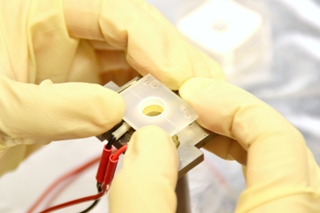Scientists at Kiel University have successfully recorded video images of the bonding of molecules in ionic liquids onto an immersed electrode. Thanks to modern microscopy techniques, for the first time it was possible to directly view the chemical processes in novel and unusual materials.
 The researchers use a special sample holder to investigate the ionic liquids under the microscope. Photo/Copyright: CAU, Denis Schimmelpfennig
The researchers use a special sample holder to investigate the ionic liquids under the microscope. Photo/Copyright: CAU, Denis Schimmelpfennig
These video images at the nanoscale give complete information about the way chemical components rearrange themselves upon voltage application. Recent studies based on this data can help develop more energy- efficient solar engineering or coating technology, and enhanced batteries.
Ionic liquids are basically organic salt melts that do not contain water. However, they may exist in a fluid state at room temperature. This unique property makes them suitable for industrial processes and various experiments. The reason for this is even at small voltages water is electrolytically separated at electrodes, thereby blocking other critical electrochemical reactions. Moreover, the ions are enclosed by water molecules, obstructing various chemical processes. In case of ionic liquids, it is possible to obtain new reactions.
In the past few years, ionic liquids have attracted significant attention, which led to the discovery of a wide range of innovative compounds. These liquids offer many technological applications such as a galvanic bath for depositing thin aluminium coatings or semi-conductor materials and as electrolytes in dye solar cells, fuel cells and batteries. Ionic liquids function at room temperature, which makes them convenient to handle different applications and at the same time achieve significant energy savings.
Currently, no definite information is available on how the molecules are organized on the electrode’s surface or how chemical and electrical reactions in ionic liquids function at the molecular level. Although advanced microscopy techniques have been applied to study these details over the years, similar analyses in ionic liquids continue to remain ineffective till date. In order to solve this mystery, the research team used a self-built scanning tunnelling microscope.
The molecules often simply move too fast for conventional instruments, said Professor Olaf Magnussen of Kiel University.
Magnussen's co-worker Dr Rui Wen recorded video sequences, which showed how the nano-sized molecules in the ionic liquid respond when a voltage is passed to a gold electrode. When the surface is not charged, the molecules show a reaction, which is common in case of liquids. These molecules are highly mobile and disorganized. As and when the voltage is increased, the molecules arrange themselves flatly on the surface and subsequently form rows, before reorienting themselves to an upright arrangement and simultaneously become less mobile.
The images are unique and help us to develop theories to better describe the electrode processes in ionic liquids. This is important not only for basic research, but also for concrete applications.
Professor Olaf Magnussen of Kiel University
In order to continue the study, Wen had applied for a scholarship from the Alexander von Humboldt Foundation and the research was suitably approved. In a span of two years, she has studied a wide range of ionic liquids, in addition to others liquids with BMP ions, which is the topic of the newly published research. BMP ions hold significance for battery researchers. The special microscopy method really attracted me to Kiel, added Wen.
The results of the study may provide a better insight into the ionic liquids and make it possible to customize them for more eco-friendly manufacturing processes. The studies also provided a suitable platform for Rui Wen because she received an opportunity to set up her own research team at the Chinese Academy of Sciences in Beijing.
References